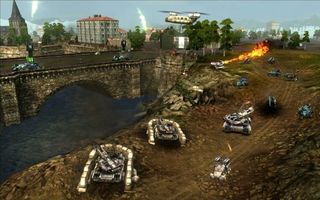There are two types of RTS players: those who dig the grueling, fast-paced competitive play of the online arena, and those who don’t. We fall into the latter category. That's not to say we don’t love amassing armies and slaughtering opponents—we just don't have the desire to master the second-to-second complexity of an elaborate build order. In just about every RTS game, skilled players decimate our units and overly developed bases time and time again. We even began to internalize the defeat, accepting that, perhaps, competitive RTS gaming is something we’d never be able to fully enjoy. And then we got some hands-on time with End of Nations.
Developed by Petroglyph Games (formed by ex- Westwood Studios employees, creators of Command & Conquer), End of Nations is a free-to-play MMORTS that differentiates itself from the RTS crowd by employing massive (up to 28 vs. 28!) battles in a persistent war-torn universe. There is no base building or micromanaging to worry about. Instead, End of Nations is all about team play and combat—and since we start each battle with our army fully formed, and there are no structures to build aside from things like turrets, victory all comes down to one thing: skill. Sure, there’s a lot of strategy involved in the moment-to-moment gameplay, but anyone with a passing interest in the RTS genre will be able to compete without feeling the urge to punch dance their rage into oblivion in a secluded, wooded glen.

Above: A look at a round of Resource Hog
There are two overlying factions in the game: the Liberation Front, a group equipped with heavy-hitting units and defensive structures, as well as the Shadow Revolution, which relies on stealthy hit-and-run tactics with units that are lightly armored but pack a hefty punch. After aligning with a faction, we then choose from a variety of “classes” (just like in any MMO), each with their own strengths and weaknesses. Some have access to heavily armored ground units and powerful mortar strikes, while others have nimble aerial units with high maneuverability.
Before jumping into a skirmish, we created our commander and got a look at the game’s primary progression system. Here, our commander can be “leveled up” by allocating skill points earned in battle. These points can be used to purchase or upgrade army units, deployable structures (like anti-air or machine gun turrets), or even commander abilities, such as mega-powerful orbital strikes. From here, we created the army (called a “company) we’d bring into battle. Each player-controlled army in End of Nations is relatively small compared to those in other RTS games. When choosing our units, we had to pay heed to our resource cap allowance (essentially End of Nation’s population cap) and how many resources each unit type required. Want to bring along a heavy Titan Tank? Be ready for it to eat up about 25 percent of your total resource cap. This system keeps each army from becoming too overpowered, and companies usually ranged in size from six to ten units. The best part? We can create several different company presets and switch them out on the fly during battle (though only one may be active at any time). For example, if we bring an army of predominantly anti-air units and our opponents have no air forces, we can switch to a company composed of mostly ground units.

Above: In Last Stand, we were charged with defending a structure against waves of enemies
This came in handy during our time with End of Nation’s Resource Hog mode, because we couldn’t anticipate which types of units our opponents would bring. In Resource Hog, teams must work together—always in groups of four—to capture and hold control points. (Think Battlefield 3’s Conquest mode, but in an RTS.) Holding a CP means our team is rewarded with a constant stream of resources, which are used to rebuild units that had been destroyed, as well as purchase turrets. With multiple CPs on the map, a healthy mix of offense and defense was necessary to protect our assets while acquiring additional points from our enemies. The match was fast-paced and hectic—figuring out how to best take advantage of each of our units’ special abilities (some tanks can sacrifice mobility for additional defense while others had powerful single-target strikes) was key, as was learning which units were most effective against certain types of enemies. It was RTS gameplay at its most basic level, but the pared down army size let us focus on mastering control of the units we had access to.
Just as challenging was Last Stand mode, which is an extremely relentless horde mode. We, along with our three teammates, were tasked with defending a single structure in the middle of the map, which had four lanes leading to it. Naturally, A.I.-controlled enemies poured through these lanes in effort to destroy the structure. Things started off easy enough; we took defensive positions and set up a parameter, dominating everything that walked within range of our turrets and mortar strikes. By the time we hit the 15th wave of enemies, though, things got a little…dicey. We started getting smashed by orbital bombardments, aerial strikes, and massive numbers of tanks and infantry all at once, and were quickly overrun. The kicker is we didn’t even make it half way through the mission. Brutal. Yet after a few rounds of both co-op and competitive play, one difference stood out compared to our online experience with other RTS games: we wanted to jump back in and do it all over again. The online offerings here won’t likely intimidate timid RTS players. Instead, End of Nations balances skill with strategy in a way that makes it accessible. There’s a deep level of complexity to be found beneath the surface—but thankfully the surface is pretty darn fun, too.
The End of Nations closed beta starts this spring. You can head here to sign up for a chance to join.

